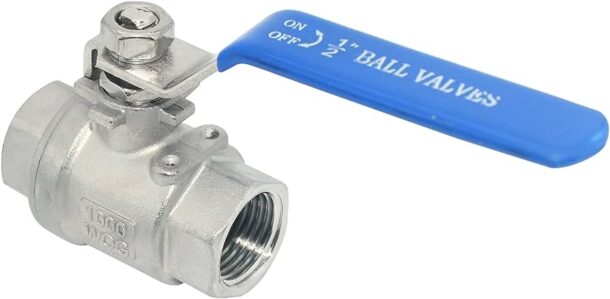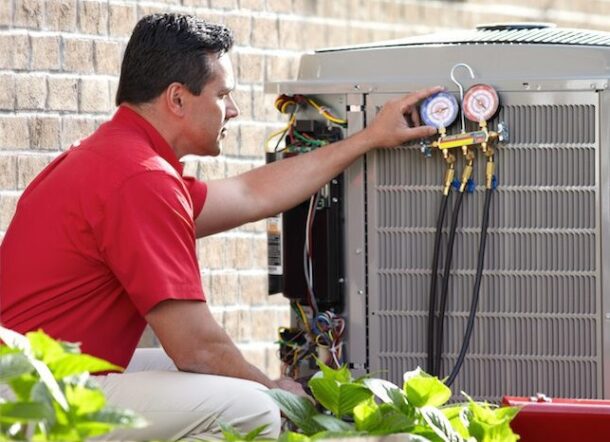Calves play a crucial role in managing the flow of steam and hot water in various systems. They are designed to withstand high temperatures and corrosion, making them essential components in industrial and residential settings. This article explores the different valves used for steam and hot water. Different valve types for hot water and steam Read more
Whats New

Calves play a crucial role in managing the flow of steam and hot water in various systems. They are designed to withstand high temperatures and corrosion, making them essential components in industrial and residential settings. This article explores the different valves used for steam and hot water.

Stainless steel ball valve with PTFE seal suitable for steam
Different valve types for hot water and steam
Solenoid valves
Solenoid valves are used in both hot water and steam systems to control fluid flow. They offer fast response times, precise flow control, and durability in challenging conditions. Their compact design and low maintenance needs make them ideal for various industrial and commercial applications.
Globe valves
Globe valves offer excellent throttling capabilities and precise flow control. These valves have a spherical body and a movable plug or disc, which regulates fluid flow by varying the opening between the plug and the valve seat. In steam applications, globe valves enable fine-tuned control over flow rates and pressure, making them ideal for processes that require accurate adjustments. In hot water systems, they provide reliable shut-off, minimizing water leakage and optimizing flow control. Globe valves are commonly used in heat exchangers, steam distribution systems, and other applications where precise flow control is essential for efficient operation.
Gate valves
Gate valves are known for their low-pressure drop and efficient shut-off capabilities. These valves utilize a gate or wedge-shaped disk that moves up and down to control the flow of fluids. In steam applications, gate valves offer minimal resistance, making them suitable for high-flow systems. When fully open, they provide a straight-line flow, ensuring efficient steam distribution. In hot water systems, gate valves deliver reliable shut-off, preventing water leakage and enabling precise flow control. Their robust design and simple operation make gate valves valuable for various industrial processes, providing reliable and efficient fluid control in both steam and hot water applications.
Ball valves
Ball valves are widely used in both steam and hot water systems due to their excellent shut-off capabilities. These valves use a rotating ball with a hole through its center to control the flow of fluids. For steam applications, ball valves provide a quick and reliable shut-off, preventing steam leakage. In hot water systems, they offer fast and efficient flow control, minimizing water wastage. Their simple design and durable materials make ball valves a popular choice for various industrial and commercial applications, providing reliable performance and ease of operation in both steam and hot water systems.
Butterfly valves
Butterfly valves feature a disc that rotates within the valve body to regulate fluid flow. In steam applications, butterfly valves offer fast shut-off capabilities, making them suitable for applications where quick isolation is required. In hot water systems, they provide reliable flow control, minimizing water waste and energy consumption. Butterfly valves are particularly advantageous for larger pipelines due to their compact design, resulting in lower installation costs.
Check valves
Check valves are essential components used in steam and hot water systems to prevent backflow and maintain flow in one direction. Check valves are commonly used in boiler feedwater systems, steam distribution lines, and hot water circulation systems. Their simple design and reliable functionality make check valves crucial for maintaining system integrity and safety in both steam and hot water applications.
Steam and hot water valve features
The typical features of valves used with steam and hot water include:
- Material compatibility: Valves for steam and hot water applications should be made from materials that can withstand the high temperatures and pressure conditions. Common materials used include stainless steel, brass, bronze, ductile iron, and cast iron.
- Sealing mechanism: Valves should have reliable sealing mechanisms to prevent leakage and ensure tight shut-off when required. Seals and gaskets made from materials like PTFE (Teflon) or graphite are commonly used for their heat-resistant and sealing properties. Graphite is especially used in high-temperature applications due to its excellent thermal resistance. While not as flexible as other materials, metal seals provide a very high level of sealing integrity.
- Pressure rating: Valves must be rated to handle the specific pressure levels of steam and hot water systems to prevent failures and ensure safe operation.
- Temperature range: The valves should be capable of functioning effectively within the temperature range of the steam and hot water applications without losing performance.
- Flow control: Smooth and precise flow control is essential for maintaining efficient operation and avoiding pressure fluctuations in steam and hot water systems.
- Low pressure drop: Valves with low pressure drop are preferred to minimize energy losses and ensure energy-efficient operation in high-flow systems.
- Corrosion resistance: Valves used in hot water systems should be resistant to corrosion caused by water or water treatment chemicals.
- Durability and reliability: Valves should be designed to withstand continuous operation and harsh conditions in industrial environments.
Conclusion
Selecting the right types of valves for steam and hot water applications is paramount for ensuring the safe and efficient operation of industrial systems. Each valve type possesses unique features that cater to specific requirements, such as shut-off capabilities, flow control, and resistance to high temperatures and pressures. Ball valves excel in quick shut-off, while gate valves provide low pressure drops. Globe valves offer precise throttling control, and butterfly valves are suitable for larger pipelines. Check valves prevent backflow, and safety relief valves protect against overpressure situations. Understanding these valve types and their features empowers engineers and professionals to make informed decisions, optimizing system performance, energy efficiency, and safety in the complex world of steam and hot water applications.

You have a lot to think about and do on any given day as a business owner. It can be easy to get a bit distracted and feel lost at times. However, you should recognize this as an opportunity to grow instead of letting it get you down. What you don’t want to do is Read more
You have a lot to think about and do on any given day as a business owner. It can be easy to get a bit distracted and feel lost at times. However, you should recognize this as an opportunity to grow instead of letting it get you down.
What you don’t want to do is ignore the struggles or wish them away. Instead, it will require some hard work and a concentrated effort on your part. In your case, first, take the time to review some tips to get your business back on the right track so you can ultimately thrive.
Schedule Employee Performance Reviews
You likely have at least a handful of employees on your team as a company owner. It can be difficult to juggle your responsibilities and manage your staff when you have a lot going on. It’s essential that you are proactive in this area because it’s costly and frustrating to have to keep replacing your employees. What you can do is closely track what people are working on and their performance. It’s in your best interest to schedule regular employees’ performance reviews to evaluate more about how they’re doing overall and what goals they have. This is also a good time to see if there’s anyone who would be a good fit for a promotion or a pay raise. Spend time discussing what struggles they have at work and in what areas they may be able to develop and grow.
Analyze & Strategize
It’s also a must that you take the time to step back and do some analyzing and strategizing as a business owner. This can be anything from your finances to your business plans and goals. Be sure to collect and review raw data so you aren’t guessing or making assumptions about what direction to go next. It may be possible that you’d like external help with this task. The good news is there are companies out there such as https://txidigital.com/services/strategize that specialize in this area and who can help lead you down the right path. There are market and product opportunities out there that you may not be aware of. Reflecting and reworking your objectives is a great starting point for getting your company back on the right track to finding success.
Talk to Your Customers
You should also be working hard to gather feedback from your customers at a time like this. Get your business back on the right track by reaching out and talking to your customers often. This way you can have more insights available to you so you can make impactful changes to how you operate. You must be meeting your customer’s needs and keeping the lines of communication open throughout the year. They likely have valuable insights to share with you that you may not be aware of as the company owner. This is also a great time to thank them for their business and let them know how much you appreciate them working with you and your company. Avoid taking this information personally and instead use it to your advantage so you can get and stay ahead in your industry.
Identify Your Priorities & Eliminate Distractions
These days there are so many different elements that can distract you as a business owner. It’s wise to take a step back and ensure that you are staying focused overall. Sit down and identify your particular initiatives and priorities so you know where to direct your attention at work. There may be people or different technology pieces that can get in the way of you excelling. Make sure you are working and concentrating on the areas and tasks that will help push your business forward in a better direction. If you try to take on too much at once you risk not getting done what you intended and having even more setbacks and obstacles to deal with at work.

Revisit Your Marketing Plan
You must be willing to invest in marketing as a business owner these days. There are a lot of opportunities available to you but also a lot of noise to cut through. Take this time to revisit your marketing plan or strategy. Figure out what’s working based on results and metrics and what particular campaigns or initiatives you may be able to eliminate altogether. It’s important that you measure your marketing so you know what’s helping you bring in more customers and profits. Now is a great time to put your heads together at work and to be more creative both online and offline about how you’re communicating with and advertising to your target audience. Make sure you know who they are and where they are spending their time.
Figure Out Where You Can Outsource
You are only one person and only have so much attention to give in your role. You may have strengths in some areas and realize there are also areas for improvement for you. In the case that you’re spread too thin or need more help with certain tasks then consider outsourcing. There are many professionals and companies out there that will be able to step in and assist you. This is also beneficial to you in your position because it’ll free up more of your time to focus on running your company. You’ll find you have more time in your schedule to do so which will take some stress off of you. You’ll also sleep better at night knowing that certain to-dos are being taken care of by the experts. For example, you may choose to outsource your IT support or your marketing efforts, which are some difficult areas to do all by yourself or with a limited staff and budget.
Find Ways to Innovate & Grow
Another tip to help you get your business on the right track is to head back to the drawing board and be more creative. There are so many different opportunities you have for yourself in your position but you have to be willing to take calculated risks. Look for various ways to innovate and grow your business, for example. While it’s good to be aware of the present moment and situation you should also always be looking to your future.
Growing a business takes time so be patient with yourself as you figure out your new plan. It’s also wise to identify what types of resources and help you will need to take your business to the next level. Be willing to collect different ideas from your employees and leadership team and start experimenting with them. You’ll want to track your progress and monitor results to see what is helping move you forward and what may be instead holding you back. Keep in mind that you will need a solid plan for how you will advance versus trying to play guessing games about what you will need to charge ahead and grow.
Have A Determined Mindset
Knowing that your company is a few steps behind or even struggling can be stressful. You must find ways to manage your stress so you can keep your focus and establish strong emotional intelligence. It’s a must that you have a determined mindset and can be resilient at a time like this. You must keep a positive attitude about your situation and be able to persevere through the obstacles you will inevitably face when you are a business owner. If you have a business mentor now is a good time to reach out to them and have him or her assist you with how you will overcome challenges and stay level-headed. They are a great resource to use in your circumstance and can offer insights based on their experience so you can avoid making similar mistakes they may have made in their career.
The construction industry, characterized by its large-scale operations and reliance on hardy materials, may seem worlds apart from the precision-driven field of machining. However, the lines between these two industries are beginning to blur, paving the way for a new paradigm in the realm of construction. Traditionally, machining has been associated with the creation of Read more
The construction industry, characterized by its large-scale operations and reliance on hardy materials, may seem worlds apart from the precision-driven field of machining. However, the lines between these two industries are beginning to blur, paving the way for a new paradigm in the realm of construction.
Traditionally, machining has been associated with the creation of small, intricate parts in sectors such as aerospace, automotive, or electronics. This process involves the controlled removal of material from a workpiece to create a specific shape or structure, often requiring a high level of precision and accuracy. On the other hand, the construction industry has primarily been about assembling structures on a large scale, usually on-site and often involving significant manual labor.
However, as technological advancements permeate both fields, a fusion of construction and machining is emerging. This convergence is largely driven by the growing recognition of machining’s potential in enhancing the quality, efficiency, and safety of construction processes.
In this new paradigm, elements of a structure are often machined off-site in a controlled environment before being transported and assembled at the construction site. This approach, known as off-site construction or prefabrication, is gaining traction for its ability to reduce waste, increase precision, and improve working conditions.
Within the realm of machining, various techniques are finding their place in construction, from milling and drilling to more sophisticated processes like curve generation. This integration of machining into construction is not just transforming how structures are built, but it is also redefining the boundaries of what is possible in the industry. Let’s delve deeper into how this fusion is playing out in specific areas of construction.
Enhancing Structural Integrity and Durability with Precision Machining
Structural integrity and durability form the backbone of any construction project. Here, precision machining techniques are beginning to prove invaluable by offering a degree of control and accuracy previously unattainable in traditional construction processes.
One of the primary benefits of employing machining techniques in construction is the ability to create components with incredibly high precision. These techniques can produce parts with tight tolerances, meaning they fit together with minimal gaps or overlaps. This precision ensures a more secure fit and greater stability in the final structure, resulting in improved structural integrity.
Furthermore, machining processes can enhance the durability of construction components. By precisely controlling the material removal process, machining can minimize defects or inconsistencies in the components, which could otherwise compromise their strength or longevity. For instance, machined steel or aluminum parts for load-bearing structures can be produced with specific properties, such as thickness and hardness, to meet exact design specifications and withstand predefined loads.
Machining can also introduce features that improve the functionality and lifespan of construction components. For example, the process can create specific surface textures or finishes that can enhance a material’s resistance to environmental factors such as moisture, temperature fluctuations, or corrosive agents.
Additionally, the incorporation of precision machining in the production of custom fasteners and fittings used in construction ensures a high-quality connection between different parts of a structure, further enhancing its overall stability and durability.
The Role of Curve Generation in Construction
In the realm of architecture and construction, the demand for designs featuring intricate curves and complex geometric patterns has been on the rise. Realizing these designs in physical structures, however, presents a significant challenge. This is where the application of advanced machining techniques, particularly curve generation, comes into play.
Curve generation is a fundamental process in machining that involves the creation of a curve on the surface of a workpiece by toolpath control. It is commonly used to manufacture gears, camshafts, and other components requiring specific, accurate curves in industries like automotive and aerospace. Yet, its value extends beyond these traditional applications and is increasingly recognized in the field of construction.
The introduction of curve generation in construction has revolutionized the way complex architectural designs are realized. By employing computer numerical control (CNC) machines capable of curve generation, it is possible to fabricate construction components with precise, intricate curves and shapes, thus enabling the translation of complex architectural designs from blueprint to reality
For instance, in the creation of custom molds for concrete or architectural façade elements, curve generation can help to produce components with specific, intricate designs. This can bring a unique aesthetic appeal to buildings, contributing to a distinctive architectural identity.
Moreover, curve generation can play a crucial role in constructing efficient structural elements, such as curved beams or arches, that distribute loads more evenly and thereby improve structural stability. These components, crafted with a high level of precision, not only enhance the structure’s aesthetics but also its functionality and durability.
Improved Efficiency and Safety
The integration of advanced machining techniques into construction practices is creating a ripple effect, leading to notable improvements in both efficiency and safety – two critical factors in any construction project.
Efficiency in construction often translates to reduced costs, streamlined operations, and shorter project timelines. Machining techniques, particularly when automated, can significantly enhance the efficiency of the construction process. For instance, using CNC machines for curve generation or other complex tasks can significantly reduce the time required to produce custom components. Automation also reduces human error, leading to a lower rate of faulty parts and rework.
Moreover, machining allows for off-site fabrication of components. This can reduce on-site work, minimize disruptions, and streamline the construction timeline. Off-site fabrication also enables better quality control, as components are manufactured in a controlled environment before they are transported to the construction site.
In addition to efficiency, machining techniques also contribute to improving safety in the construction industry. By minimizing the need for manual handling and on-site adjustments of components, machining reduces the potential for workplace accidents. It also alleviates the need for workers to perform tasks in hazardous conditions, such as high heights or in poor weather, as more elements of a structure are prefabricated off-site.
Furthermore, precision machining can contribute to the long-term safety of the built structures. By enabling high-quality, precise components, machining techniques can enhance structural stability, potentially reducing the risk of structural failure over time.
A Look at Future Possibilities
As we delve deeper into the integration of advanced machining techniques in the construction industry, it becomes clear that we are only at the dawn of a significant shift. The future possibilities are vast and hold the potential to redefine the landscape of construction as we know it.
The growing demand for sustainable and energy-efficient buildings may drive further innovations in the application of machining techniques. For instance, machining could play a vital role in creating components for passive solar buildings or smart homes, where precise design and manufacturing are crucial.
Additionally, the increasing adoption of advanced materials in construction, such as composite materials or smart glass, will likely necessitate further advancements in machining techniques. Machining these materials with precision will enable us to harness their full potential in a construction context, contributing to both the functionality and aesthetic appeal of modern buildings.
The future may also see a greater fusion of digital technologies, like 3D modeling and CNC machining. This fusion could enable more seamless workflows, from design to fabrication, and allow for an even greater level of precision and customization in construction projects.
Moreover, as automation and AI technologies continue to evolve, we could see further enhancements in the efficiency and safety benefits provided by machining in construction. Imagine construction sites where automated machining systems work alongside human operators, delivering components just in time and with pinpoint accuracy.
In conclusion, as the construction industry continues to adopt and integrate machining techniques, we can expect to witness a significant evolution in how structures are designed, built, and maintained. These advanced manufacturing techniques are not just enhancing the quality and efficiency of construction; they are pushing the boundaries of what’s possible, setting the stage for a future where construction is more precise, more efficient, safer, and more innovative than ever before.

The building and construction industry has always been at the epicenter of societal progress, evolving in tandem with the ever-changing landscape of technological advancements. From the use of rudimentary tools in the past to the current integration of sophisticated technologies, the industry’s face is continuously reshaped by the embrace of innovation. As we delve into Read more
The building and construction industry has always been at the epicenter of societal progress, evolving in tandem with the ever-changing landscape of technological advancements. From the use of rudimentary tools in the past to the current integration of sophisticated technologies, the industry’s face is continuously reshaped by the embrace of innovation. As we delve into the heart of the 21st century, emerging technologies are increasingly making their mark, promising to transform the way building trades operate. Here, we seek to highlight these significant changes as we journey through the evolution, current trends, and the future of building trades.
The Evolution of Building Trades: A Historical Perspective
In order to fully appreciate the transformative impact of today’s emerging technologies on building trades, it’s important to understand the historical progression of this vital industry. From the monumental constructions of the Pyramids of Giza, crafted meticulously with primitive tools and manual labor, to the sophisticated architectural marvels of today, the history of building trades is a testament to the human spirit’s relentless pursuit of innovation.
The Industrial Revolution in the 18th and 19th centuries marked a pivotal point in the evolution of building trades. Introduction of machinery, such as steam-powered cranes and excavators, significantly enhanced construction capabilities, enabling larger and more complex structures. The era also saw the development of new materials like steel and concrete, which revolutionized construction techniques.
Throughout the 20th century, advancements continued with the emergence of prefabrication and modular construction techniques. This period also introduced advanced machinery and equipment, such as hydraulic excavators and tower cranes, thereby improving efficiency and safety on construction sites.
In recent decades, the dawn of digital technology has ushered in a new era for the building trades. Computer-aided design (CAD), Building Information Modeling (BIM), and other software solutions have streamlined the design and planning process, fostering accuracy and collaboration.
As we step into the future, we see a continuous trend of technological integration within the building trades. With the advent of advanced materials, artificial intelligence, 3D printing, and more, the evolution of the building trades is an ongoing journey.
Current Trends and Challenges in the Construction Industry
Despite the encouraging influx of new technologies and techniques, the construction industry today faces a unique set of trends and challenges. These reflect the evolving demands of the market, environmental concerns, labor dynamics, and the accelerating pace of technological change.
- Sustainability and Green Building: The increasing awareness about environmental sustainability has put green building practices at the forefront of industry trends. More and more projects are prioritizing energy efficiency, resource conservation, and the use of renewable and recyclable materials. This shift towards sustainable construction, while beneficial, also introduces the challenge of sourcing and integrating these materials and technologies effectively.
- Labor Shortages: The construction industry faces an ongoing labor shortage, with a significant gap between available jobs and skilled workers. This is compounded by an aging workforce and a lack of younger workers entering the trades. Technological solutions can help bridge this gap, but they also require investment in training and development to ensure the workforce can adeptly handle these new tools.
- Digital Transformation: Technology is reshaping the construction industry in profound ways. From the use of drones for site inspections to AI for project management and predictive analysis, the influence of digital technology is undeniable. While these technologies offer promising benefits, they also pose challenges in terms of adoption, adaptation, and cybersecurity.
- Economic Uncertainty: Market volatility and uncertainty, driven by factors like trade disputes and the ongoing impact of the COVID-19 pandemic, pose significant challenges. Fluctuating material costs, supply chain disruptions, and changing regulations can greatly impact project timelines and profitability.
These trends and challenges paint a complex picture of the current state of the construction industry. As it navigates these waters, the industry must continue to innovate, adopting novel solutions and techniques.
From Blueprint to Build: The Rising Role of Technology
As the construction industry grapples with contemporary challenges, technology is emerging as an invaluable ally. The progression from traditional blueprint to the digital build is evidence of the industry’s increasing reliance on advanced technology to streamline operations, improve efficiency, and overcome labor shortages.
Digitized Design and Planning: Software applications such as CAD and BIM have revolutionized the design and planning phase. These digital tools facilitate collaboration, improve accuracy, and allow for early detection of potential issues, which saves time and resources in the long run. Virtual and augmented reality technologies are also increasingly used to create immersive visualizations, improving client communication and refining designs before construction begins.
Construction and Project Management Technology: Artificial Intelligence (AI) and Machine Learning (ML) are making their way into project management, providing predictive insights to avoid delays, optimize scheduling, and manage resources more efficiently. Additionally, cloud-based software platforms facilitate real-time communication and data sharing, enhancing coordination among project teams.
Automation and Robotics: To mitigate the labor shortage and enhance precision, robotics and automation are becoming more prevalent in construction. Autonomous or semi-autonomous machines, drones for surveying and inspections, and even 3D printing technologies are increasingly being utilized.
Smart Materials and Building Systems: Technology is not limited to machinery and software. The development of smart materials and integrated building systems, such as self-healing concrete or energy-efficient HVAC systems, represents another dimension of technological influence on construction.
Interestingly, the integration of technology is not just about the big and obvious changes. Subtle, yet impactful innovations are also shaping the industry. One such surprising innovation is the application of etching, especially titanium etching, a process more commonly associated with manufacturing and microfabrication, that has found a place in the world of construction.
Unveiling Etching: Titanium Etching and its Unique Applications
Etching is a process typically associated with manufacturing sectors such as electronics or aerospace, where it’s employed to create intricate designs on metal surfaces. At its most basic, etching involves the use of chemicals to remove specific areas of a metal surface, resulting in a desired pattern or design.
Titanium etching, in particular, utilizes this method to create precision components from sheets of titanium. Thanks to its high strength-to-weight ratio, excellent corrosion resistance, and compatibility with numerous alloys, titanium and its etched products find diverse applications in industries ranging from medical to automotive. Yet, what relevance does this process hold for the world of building trades and construction?
Innovative applications of titanium etching in construction are beginning to surface. The precision of etching can be used to create custom components for specialized construction needs, especially where conventional fabrication methods may fall short. This could include intricate parts for complex architectural designs or high-precision components in smart building systems.
Furthermore, titanium’s robustness and corrosion resistance make it an excellent choice for construction in harsh environments, such as coastal buildings or structures exposed to harsh weather conditions. Etched titanium components can offer both functional and aesthetic benefits, creating opportunities for unique architectural features and durable, long-lasting construction elements.
With the increasing intersection of technology and building trades, it’s clear that to learn about titanium etching is a worthwhile investment for professionals looking to stay ahead of the curve. The future of construction may well be shaped by such seemingly peripheral technologies finding novel applications in the heart of the industry.
Shaping the Future of Building Trades: Adaptation and Growth
As we stand on the precipice of a new era in the building trades, it’s clear that the industry’s future lies in its ability to adapt, innovate, and embrace a host of emerging technologies.
In the face of challenges such as labor shortages, environmental concerns, and market volatility, the role of innovation becomes even more critical. The integration of digital tools, the use of automation and robotics, and the development of smart materials all play a crucial part in equipping the industry to navigate these hurdles.
Moreover, the construction industry’s trajectory is not just about solving problems. It’s also about creating new opportunities, exploring untapped potential, and constructing not just buildings, but a sustainable, resilient future. It’s about shaping our world, one build at a time, with every innovation – be it a high-tech software solution or a precise etching technique – contributing to this transformative journey.
In conclusion, the future of building trades will undoubtedly be shaped by its ability to integrate and leverage new technologies, even from seemingly unrelated fields. This opens a world of possibilities for what we can construct and how we build, paving the way for an exciting, innovative, and resilient future for the construction industry.

As the summer heat intensifies, having a functioning air conditioning (AC) system in your home or business becomes essential. If your AC system is old or not functioning properly, it may be time to consider AC replacement in Stillwater, OK. In this blog, we will discuss the signs that it’s time for AC replacement, the Read more
As the summer heat intensifies, having a functioning air conditioning (AC) system in your home or business becomes essential. If your AC system is old or not functioning properly, it may be time to consider AC replacement in Stillwater, OK. In this blog, we will discuss the signs that it’s time for AC replacement, the benefits of AC replacement, and how it compares to AC repair. We will also provide information on AC replacement services, and how to choose the right AC replacement system for your needs.

Signs That It’s Time for AC Replacement:
There are several signs that indicate it’s time for AC replacement. One of the most common signs is that your AC system is over 10 years old. As AC systems age, they become less efficient and more prone to breakdowns. If your AC system is constantly breaking down or requiring repairs, it may be more cost-effective to replace the entire system.
Another sign that it’s time for AC replacement is that your energy bills are increasing. Older AC systems are less energy-efficient, which means they require more energy to cool your home or business. If you’ve noticed a significant increase in your energy bills, it may be time to consider AC replacement services.
Benefits of AC Replacement:
There are several benefits to AC replacement. One of the most significant benefits is energy savings. Newer AC systems are more energy-efficient, which means they require less energy to cool your home or business. This can result in significant cost savings on your energy bills.
Another benefit of AC replacement is improved air quality. Older AC systems can accumulate dust, dirt, and other pollutants, which can reduce the quality of the air in your home or business. Newer AC systems have advanced filtration systems that can remove these pollutants, resulting in cleaner air.
AC Replacement vs. Repair:
When your AC system breaks down, you may be faced with the decision to repair or replace it. While repairing your AC system may be a more cost-effective option in the short term, it may not be the best long-term solution. If your AC system is old or requires frequent repairs, it may be more cost-effective to replace the entire system.

AC Replacement Services:
If you’re considering AC replacement services, there are several factors to consider. One of the most important factors is choosing the right AC replacement system for your needs. You should consider factors such as the size of your home or business, your budget, and your energy efficiency needs. A professional AC replacement service provider can help you choose the right system for your needs and provide expert installation services.
Conclusion:
In conclusion, having a functioning AC system is essential during the hot summer months. If your AC system is old or not functioning properly, it may be time to consider AC replacement services. Signs that it’s time for AC replacement include an old AC system, frequent breakdowns, and increasing energy bills. Benefits of AC replacement include energy savings and improved air quality.
When faced with the decision to repair or replace your AC system, it may be more cost-effective to replace the entire system. If you’re considering AC replacement services, it’s important to choose the right system for your needs and budget. Contact lenses have nothing to do with AC replacement services, but if you need them, be sure to consult with an eye care professional.
